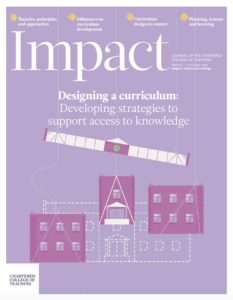Rethinking curriculum partnerships for deep learning and lasting change

Over the years, we have worked hard to make sure that our curriculum delivered authentic learning opportunities for our children, but partnerships with other organisations within our locality have made us rethink how this might be achieved.
The Royal Society of Art’s idea of an ‘area-based curriculum’ suggests how organisations in the same locality can work together for the good of all.
The aim of an ‘area-based curriculum’ seems elegant in its simplicity: to enhance the educational experiences of young people ‘by creating rich connections with the communities, cities and cultures that surround them and by distributing the education effort’ (Facer, 2009).
The notion of a curriculum about a place, by a place and for a place was something that resonated with us at St Bernard’s. The same thinking has been extended by colleagues in the North East (Leat and Thomas, 2016) and termed ‘community curriculum making’. The old proverb ‘it takes a village to raise a child’ stands well here and suggests a way to think of how we can come together for the widest opportunities for our children, and for all our futures.
Authentic partnerships
Over the last few years we have developed exciting partnerships with local organisations. Our partnership with Chester Zoo is based on a shared passion for inspiring the next generation, a belief that real learning is based on authentic experiences and that by working together we could really make a difference.
Partnership with Action Transport Theatre (ATT), a national portfolio theatre company, has developed, with a passion for the arts and a commitment to our children to provide a broad curriculum. This has led to co-commissioning the writing of a play around the story of two refugees. Our work as part of a Local Education Cultural Partnership strengthens this further.
These two partnerships have led us to work with other local schools in developing a curriculum around conservation and social justice. These themes are embedded into the everyday learning for our children, encouraging critical reflection and thinking, and ensuring that our children learn ‘the skills and knowledge base to make sense of and effectively engage in this global and fragile PIC CREDITworld’ (Bourn et al., 2016).
Keys to success
For effective long-term partnerships to become established, both parties need to benefit from the work and adopt a shared vision. Such reciprocity can be a powerful force but relationships and aims need to be clear from the outset. There also needs to be a commitment to create resources and opportunities to evaluate the effectiveness of collaboration at key milestones (Leat and Thomas, 2016).
Caution – learning at risk!
In developing the curriculum with partners, we must ensure that no rigour is lost through a themed approach. Curriculum coherence must be achieved, not only through the careful planning of progressively more complex concepts within subjects, but also through links across subjects and years. The idea of horizontal, diagonal and vertical links through the curriculum is one that many schools are already building on (Sealy, 2017). This, alongside an understanding of appropriate academic vocabulary to drive deeper learning (Quigley, 2018), provides a framework for planning our curriculum.
In our experience, it’s important to start with a mutual sharing of expertise. In working with the zoo, teachers contributed their knowledge of the content and breadth of the National Curriculum, while education staff from the zoo shared their experiences of creating resources to engage people with issues such as field conservation. Together, colleagues developed a deeper understanding of each other’s work and started to create resources combining the conservation aims of the zoo and the National Curriculum (NC). The Indonesian songbird crisis was the focal topic, and all staff developed a deeper understanding of the concern over this crisis that has led to several species becoming extinct. Through this work, we were able to gain clarity around the progressive concepts and knowledge that we wanted children to know and understand in each subject. The conservation context was a key driver in motivating staff and children, but it also deepened our understanding of ‘content’ (Oates, 2011).
Strength in numbers
As a small school, the work needed to plan a curriculum is vast. Working with specialist partners is a really valuable way to build a curriculum with real coherence. A spirit of collaboration and enquiry with a clear purpose is a powerful tool.
Resources like Twitter and Google Classroom can also be useful in bringing teachers together as they work towards developing their own curricula. You only need to look at #IgniteZoo18 to see the ideas and enthusiasm that have been generated across schools in the North West through this partnership approach.
Partnerships can become the bedrock for igniting passion, creativity and better outcomes for our schools, communities and world. If you haven’t seen who’s out there – it’s worth taking a look!
Final thoughts
- Find your own Chester Zoo/ATT
- Plan for coherence
- Think about the value it all adds to the community/the world
References
This article was published in September 2018 and reflects the terminology and understanding of research and evidence in use at the time. Some terms and conclusions may no longer align with current standards. We encourage readers to approach the content with an understanding of this context.










